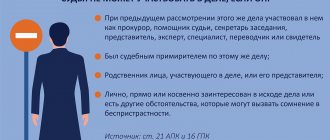ST 320 of the Criminal Code of the Russian Federation.
1. Disclosure of information about security measures applied to an official of a law enforcement or regulatory body, as well as his relatives, if this act was committed in order to impede his official activities, is punishable by a fine in the amount of up to two hundred thousand rubles or in the amount of wages or other income of the convicted person for a period of up to eighteen months or arrest for a period of up to four months.
2. The same act, which entailed grave consequences, is punishable by forced labor for a term of up to five years or imprisonment for the same term.
Commentary to Art. 320 of the Criminal Code of the Russian Federation
Commentary edited by Esakova G.A.
1. Distinctive features of this crime, which has common objective features with the features of the offense provided for in Art. 311 of the Criminal Code, first of all, is determined by the circle of victims. These include those specified in the Federal Law of April 20, 1995 N 45-FZ “On state protection of judges, officials of law enforcement and regulatory authorities”: a) officials of law enforcement agencies; b) officials of regulatory authorities; c) their loved ones.
2. The objective side is the disclosure (publication, unauthorized communication) to unauthorized persons or at least one of them of all or part of the information about the security measures applied to these persons (Part 1). Whether and how the disclosed information will be used does not matter for qualification under Part 1.
3. Criminal liability under Part 2 occurs in cases where the committed act caused grave consequences, which may consist of death, serious harm to human health, or significant property damage. Guilt in relation to them, within the meaning of the law, is characterized by negligence.
4. A mandatory feature of the subjective side is the goal of preventing the legitimate activity of the victim (preventing, stopping or changing it).
5. Special subject: it can only be persons legally, i.e. by trust or service, having the relevant information.
Commentary to Art. 320 Criminal Code
1. Distinctive features of this crime, which has common objective features with the features of the offense provided for in Art. 311 of the Criminal Code, first of all, is determined by the circle of victims. These include those specified in the Federal Law of April 20, 1995 N 45-FZ “On state protection of judges, officials of law enforcement and regulatory authorities”: a) officials of law enforcement agencies; b) officials of regulatory authorities; c) their loved ones.
2. The objective side is the disclosure (publication, unauthorized communication) to unauthorized persons or at least one of them of all or part of the information about the security measures applied to these persons (Part 1). Whether and how the disclosed information will be used does not matter for qualification under Part 1.
3. Criminal liability under Part 2 occurs in cases where the committed act caused grave consequences, which may consist of death, serious harm to human health, or significant property damage. Guilt in relation to them, within the meaning of the law, is characterized by negligence.
4. A mandatory feature of the subjective side is the goal of preventing the legitimate activity of the victim (preventing, stopping or changing it).
5. Special subject: it can only be persons legally, i.e. by trust or service, having the relevant information.
Commentary on Article 320 of the Criminal Code of the Russian Federation
Commentary edited by Rarog A.I.
1. The crime encroaches on public relations that develop in the process of ensuring the confidentiality of information about security measures applied to officials of law enforcement and regulatory authorities, as well as their relatives.
2. The subject of the crime is information about security measures applied to the above-mentioned persons or their relatives.
3. Several categories of persons to whom security measures are applied can be distinguished as victims:
a) a law enforcement official;
b) an official of the regulatory body;
c) their loved ones.
If information about security measures applied to a judge or participants in criminal proceedings is disclosed, liability arises under Art. 311 CC.
4. On the concept of an official, see note 1 to Art. 285 CC.
5. For the concepts of law enforcement and regulatory authorities, see the note to Art. 318 CC.
6. On the concept of loved ones, see the commentary to Art. 317 CC.
7. In accordance with Art. 5 of the Federal Law of April 20, 1995 “On state protection of judges, officials of law enforcement and regulatory authorities” (with subsequent amendments) to officials of law enforcement and regulatory authorities to ensure the protection of their life and health and the safety of their property by security agencies, The following security measures may be applied depending on specific circumstances:
1) personal protection, protection of home and property;
2) issuance of weapons, special personal protective equipment and danger warnings;
3) temporary placement in a safe place;
4) ensuring the confidentiality of information about protected persons;
5) transfer to another job (service), change of place of work (service) or study;
6) relocation to another place of residence;
7) replacement of documents, change in appearance.
8. The objective side of the crime provided for in the commented article is characterized by making public information about security measures applied to persons specified in the law. Disclosure is evident if the information becomes available to at least one person who does not have the right to become familiar with it.
It seems that, within the meaning of the law and taking into account the purpose of disclosure, information is disclosed to interested parties who have the opportunity to use the information received and thereby impede the activities of officials of the relevant bodies. Announcement is possible in any way: orally, in writing, in person, anonymously, in a public speech, in conversation, etc.
9. The crime is considered completed from the moment the information becomes available to an outsider.
10. The subjective side of this crime is characterized by guilt in the form of direct intent. A mandatory feature is also the purpose of obstructing the official activities of a law enforcement official or regulatory authority, i.e. the desire of the perpetrator to interrupt or stop such activities.
11. The subject of disclosure of security measures can only be a person who has reached the age of 16 years, to whom this information was entrusted or became known in connection with official activities.
The persons to whom this information is entrusted include those who directly provide measures for the security of protected persons, are employees of special security services that are part of the structure of the Ministry of Internal Affairs, the FSB, the tax police, and military units.
Persons to whom this information became known through their service include those to whom this data is available due to their official position: employees of the prosecutor's office, police department, managers and employees of address bureaus, passport services, etc.
12. Part 2 of the article in question provides for grave consequences as a result of the disclosure of information about security measures applied to an official of a law enforcement or regulatory agency.
The concept of “grave consequence” is an evaluative category and is determined depending on the specific circumstances of the case.
13. The mental attitude of the perpetrator to the onset of grave consequences is characterized by a careless form of guilt in the form of frivolity or negligence. The intentional form of guilt is excluded here, since otherwise there is complicity in a crime (for example, murder, intentional infliction of grievous bodily harm, etc.).
Comments on the article
The characteristics of the crime in question generally coincide with the characteristics of the crime under Art. 311 CC. These acts differ in their social orientation, therefore, in the content of the object and the circle of victims, as well as in the subjective side of the crime.
The direct object of the crime in question is management activities that ensure the safety of life, health, and the safety of the property of persons taken under protection, as well as the persons implementing it. The subject of the crime is information about security measures applied to persons specified in the law.
Victims may be persons subject to state protection (officials of a law enforcement or regulatory agency, as well as their relatives), and persons providing this protection.
The objective side of the crime is characterized by the disclosure of information about the security measures of the relevant persons.
On disclosure, see commentary to Art. 311 CC.
The crime is completed from the moment the information becomes known to a person who has nothing to do with it.
The subjective side of the crime is characterized by direct intent and a special purpose - obstructing the official activities of a law enforcement official or regulatory authority.
The subject of the crime is a person who:
- information about security measures is entrusted;
- this information became known in the service.
The first category includes persons who directly implement measures to ensure the safety of protected persons: employees of internal affairs bodies, the federal security service, etc.
The second group includes employees of enterprises, bodies and institutions to whom decisions of security authorities are sent (employees of address bureaus, passport services, telephone exchanges, etc.).
The occurrence of grave consequences as a result of the disclosure of information about security measures entails liability under Part 2 of Art. 320 CC; their content is revealed in the same way as in the crime provided for in Art. 311 CC. Guilt towards them can be expressed in the form of frivolity or negligence.
Commentary on Article 320 of the Criminal Code of the Russian Federation
Commentary edited by A.V. Brilliantova
The main object of the crime is the normal activity of government bodies. An additional object is the safety of law enforcement and regulatory officials, as well as their loved ones.
The social danger of the crime in question lies in the fact that, as a result of disclosure, the security measures applied lose their effectiveness, and the above-mentioned subjects become vulnerable to any negative impact on them. This can negatively affect the activities of government officials and lead to serious consequences.
State protection of judges, officials of law enforcement and regulatory agencies, as well as their relatives is established by Federal Law of April 20, 1995 N 45-FZ “On state protection of judges, officials of law enforcement and regulatory agencies.” The list of persons subject to protection is given in Art. 2 of the said Law. These include, in particular: persons carrying out operational investigative activities; employees of federal internal affairs bodies protecting public order and ensuring public safety; employees of institutions and bodies of the penal system; employees of the control bodies of the President of the Russian Federation, monitoring the implementation of laws and other regulatory legal acts, identifying and suppressing offenses; employees of federal state security agencies; employees of customs and tax authorities, federal state control authorities, the Federal Service for Financial Monitoring, the Accounts Chamber of the Russian Federation, as well as other categories of state and municipal employees.
The concept of “close” was considered in relation to Art. 105 of the Criminal Code of the Russian Federation.
The objective side of the crime is characterized by action and consists of disclosing information about security measures applied in relation to the persons specified in the disposition of the norm in question. Disclosure is the unlawful publication of information about security measures applied to a law enforcement or regulatory official or their relatives. The method of disclosure of information does not matter for the classification of the crime.
Disclosure of information can be made in the form of an action: during a conversation, transfer of documents, demonstration of an audio or video recording, message in the media, by telephone, e-mail, etc.
According to the construction of the objective side, the corpus delicti provided for in Part 1 of Art. 320 of the Criminal Code of the Russian Federation is formal. Disclosure of information about security measures is considered a completed crime from the moment this information becomes known to at least one person who is not allowed to know about the relevant security measures. In this case, it is necessary that such a person understands the meaning of the information he receives. If the specified person does not understand the disclosed information, there is an attempt to commit a crime (Part 3 of Article 30 and Article 320 of the Criminal Code of the Russian Federation).
The subjective side of the crime is characterized by direct intent. For the existence of a crime, the obligatory sign of the subjective side is the goal of interfering with official activities. The motives for disclosure can be different: to take revenge on a law enforcement officer, to boast of one’s knowledge, to receive material gain, etc.
The general subject of the crime is a sane person who has reached the age of 16 years.
The qualifying feature of the crime under consideration (Part 2 of Article 320 of the Criminal Code of the Russian Federation) is the commission of an act that entailed grave consequences (for example, an attempt on the life of an official of a regulatory body, causing harm to health, serious material damage). The concept of grave consequences is not defined in the law - it is evaluative and must be determined in each specific case.
The grave consequence that occurs must be in a causal connection with the disclosure by the perpetrator of information about the security measures applied in relation to one or another protected person. The qualified corpus delicti is material. The crime will be completed from the moment the socially dangerous consequences occur.
The subjective side of this composition can be characterized by guilt in the form of direct or indirect intent, as well as two forms of guilt.




